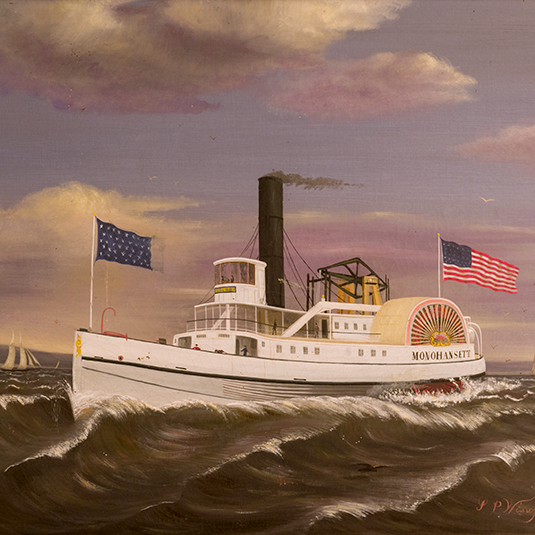100 Years, 100 Stories

100 YEARS, 100 STORIES
Objects tell stories, even if they were not designed to. They reflect the times and places in which they were created and illuminate the lives of those who made and used them. The hundred objects in 100 Years, 100 Stories (drawn from tens of thousands in the Museum’s collection) each have an individual story to tell and are grouped around 12 broad themes. In each month of 2023, the Museum’s 100th year, we’ll add a new theme to this page, exploring the many ways in which the Island’s past shapes its future.
JANUARY:
Artists of this Island
Made to tell stories, as symbols of prestige, or for sheer visual pleasure, works of art offer an avenue to understanding that books and documents do not. Artists on Martha’s Vineyard, whether they worked long ago or are working here now, put their creativity into objects that represent this Island and its people across cultural and economic boundaries to create a multi-faceted impression of this place.


FEBRUARY:
Island of Immigrants
Only the Wampanoag can legitimately claim to be the first people on Martha’s Vineyard. Everyone else is descended from English colonists who arrived in the 17th century, or from people who landed here in subsequent waves of immigrants, or came as families or individuals in search of a life better than the one they left behind. This immigration, and its enrichment of the Island’s culture, continues to this day.
MARCH:
Getting Here
Inhabitants of Martha’s Vineyard have been crossing the open water dividing it from the mainland for seven thousand years: in dugout mishoons, in wind-driven sloops and catboats, and (for two centuries) in ships driven by steam and diesel engines. The introduction of modern car ferries and scheduled air service after 1945 made travel to the Vineyard easier, but not effortless. Wind and weather still cut off service from time to time, reminding us that, despite all our technological advances, the Vineyard is still an island.


APRIL:
Turning a Profit
Martha’s Vineyard’s proximity to major sea lanes and large summer population (a feature of Island life since the end of the Civil War) create unique business opportunities, but turning a profit on the Island also presents unique challenges. The Vineyard’s tiny year-round customer base, limited resources, and inability to compete with large mainland producers are significant challenges, and entrepreneurs’ responses to them have become part of Island culture.
MAY:
Harvesting the Sea
Islanders have long subsisted off the animals living in the sea and made a living from them as well – harvesting creatures from local ponds to feed their families, fishing the waters surrounding the Island to sell their catch for profit, and traveling the world to hunt whales for oil and baleen. The first European colonizers of the Island marveled at the seemingly limitless bounty of the sea but, as with so many natural resources, that limitlessness was an illusion.


JUNE:
Building on Sand
The land that the Wampanoag call Noepe and English colonists called Martha’s Vineyard was bulldozed into place 20,000 years ago by the glaciers of the last great ice age. The melting of those glaciers, and the steady rise in sea level that followed, transformed it into an island 5-6,000 years ago. The Wampanoag lived lightly on the land, but English traditions of individual land ownership and large, permanent coastal settlements set them at odds with the natural processes shaping the Island. Four hundred years later, Vineyarders are still seeking a workable middle ground.
